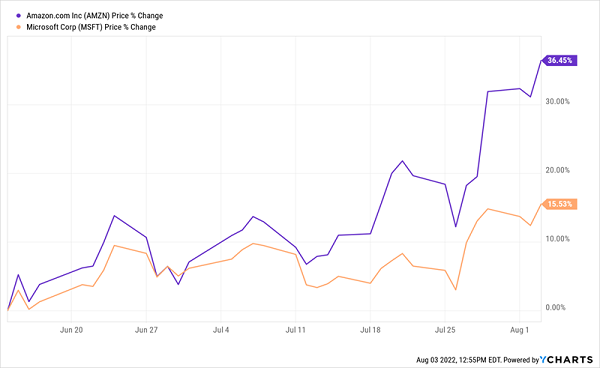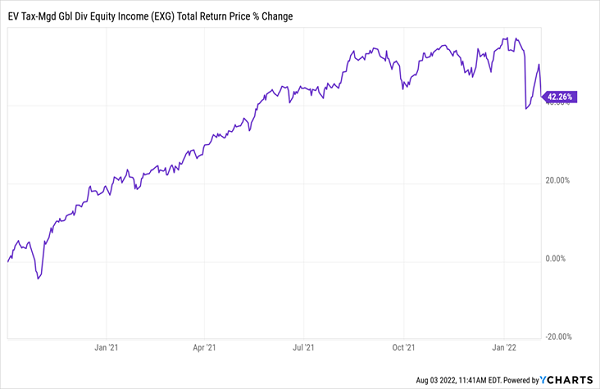Just a couple weeks ago, many folks thought they had lots of time to grab beaten-down stocks like Amazon.com (AMZN) and Microsoft (MSFT). Since then, these blue-chips have really popped:
Techs Bounce—But We Can Still Buy Cheap (With 7%+ Dividends, Too)

Fortunately there is a way we can still buy AMZN and MSFT at “pre-launch” prices. And collect 7%+ yields, too!
We’re not buying the shares directly. We’re smarter than that. We’re picking these stocks up with the types of 7%+ dividends we favor in Contrarian Income Report—at steep discounts to their market prices.
This “dividend discount” method lets us “turn back the clock” and buy the dip after the dip has already happened!
We can also pick these stocks up with outsized dividend yields of 7%+. And our payouts will often come your way monthly, too. That’s a far cry from buying Microsoft on its own, with its practically nonexistent 0.88% dividend. And Amazon, of course, yields exactly 0% today—and likely always will.
How We’ll Buy Our Favorite Dividends Cheap
I bring this up now because it’s a similar situation to one we faced a little less than two years ago, in October 2020. Back then, you’ll recall, the world was mostly in lockdown, but stocks had bottomed months before—and were ripping higher almost daily.
At Contrarian Income Report, we wanted to pick up some consumer names to profit from the rebound, not to mention the trillions of dollars Jay Powell & Co. (with an assist from the US government) was pumping into consumers’ pockets.
But we sure didn’t want to pay the inflated prices these stocks were going for at the time! And because we’re a high-yield service, we demanded big dividends—ideally big enough to let us retire on our payouts alone, without having to sell a single stock in retirement.
So here’s what we did.
Using Closed-End Funds to “Turn Back the Clock” on Share Prices
Instead of buying these stocks directly, or through a low-yielding S&P 500 index fund, we went with an absurdly overlooked vehicle called a closed-end fund, or CEF.
Specifically, we picked up the Eaton Vance Tax-Managed Global Diversified Equity Fund (EXG), which yielded an unheard-of 10% at the time and sent out that dividend as a steady monthly payout, too!
Second, EXG, which held both Amazon and Microsoft back then, traded at a ridiculous 12% discount to net asset value (NAV).
Stick with me here, because these discounts are the key to “turning back the clock” and buying our CEFs’ shares at prices well below those we’d pay on the market. Because that 12% discount meant that we were, in effect, getting Amazon, Microsoft and the rest of EXG’s stocks for 88 cents on the dollar!
CEFs are the only corner of the market with this sweet inefficiency. Unlike their mutual-fund and ETF cousins, CEFs have fixed pools of shares. Which means they can trade at premiums and discounts to the values of their underlying assets.
EXG had one more tool in its kit, too: it writes covered call options on its holdings. If you’ve ever written covered calls yourself, you probably know it’s a great way to generate extra income. It’s also a pain to manage because it requires constant call writing (not to mention an options-blessing in your account!). EXG is a one-click way to outsource this strategy.
I’m sure you can see where I’m going here: buy a CEF at a particularly deep discount and you’ve got a great shot at “bonus” upside as these deals vanish, catapulting the CEF’s share price higher as they do!
That’s exactly what happened with EXG: we rode its closing discount window higher, clocking out in February 2022, by which time the fund’s discount had almost completely vanished, narrowing to 3.7%.
And the price, puppy dog-like, followed the closing discount the whole way, rising 28%. Throw in our 10% dividend and we netted out at a sweet 42% return in under three years!
EXG’s Discount Disappears, We Grab a Fast 42% Total Return

This pattern is easy to spot in CEFs: simply look for a discount that’s wider than usual, then buy—and ride along as your closing discount window drives up the share price. And, of course, you’ll collect your high—and often monthly—dividend the entire time!
One thing to note, though, is that I’m not recommending EXG, which trades at a 1.5% premium to NAV, today. But there are still plenty of other big discounts on the board, including those I recommend in Contrarian Income Report.
Get the Safe 7% Payouts You Need to Retire on Dividends Alone—Right Here
I’ve filtered out 7 of my top high-yield picks from Contrarian Income Report and dropped them into 3 Special Reports I want to share with you today.
Taken together, the 7 stocks and funds in these 3 breakthrough reports form my “7% Monthly Payer Portfolio.” As the name says, these 7 (too) often-ignored investments churn out a 7% payout that comes your way every single month.
A payout like that can give us the one thing we all dream about as income investors: the ability to retire on dividends alone!
I’ve picked these 7 stocks and funds for another reason, beyond their high dividends: they all trade well below their usual valuations. So if the market drops from here, they’ll hold up much better than the overbought stocks still out there. And if the market takes off, our monthly payers’ discounts will disappear, putting an extra lift under their share prices!
Don’t miss this chance. Click here to get my full monthly dividend strategy and grab your 3 Special Reports—including the names and tickers of the 7 “must-own” stocks and funds in my “7% Monthly Payer Portfolio” now.
Before you make your next trade, you'll want to hear this.
MarketBeat keeps track of Wall Street's top-rated and best performing research analysts and the stocks they recommend to their clients on a daily basis.
Our team has identified the five stocks that top analysts are quietly whispering to their clients to buy now before the broader market catches on... and none of the big name stocks were on the list.
They believe these five stocks are the five best companies for investors to buy now...
See The Five Stocks Here
Discover the 10 Best High-Yield Dividend Stocks for 2025 and secure reliable income in uncertain markets. Download the report now to identify top dividend payers and avoid common yield traps.
Get This Free Report